Mary Anne Yarde's Blog: The Coffee Pot Book Club , page 152
February 21, 2019
Join Historical Fiction author, E.E. Burke for a close look at Steamboat Lithograph. EE.Burke is also giving away a copy of her fabulous book — Taming Huck Finn #History #Steamboats #Giveaway @author_eeburke
Steamboat LithographBy E.E. Burke
“When I was a boy, there was but one permanent ambition among my comrades in our village on the west bank of the Mississippi River. That was, to be a steamboatman. We had a hope that if we lived and were good, God would permit us to be pirates. These ambitions faded out, each in its turn; but the ambition to be a steamboatman always remained.” ~ Mark Twain
TAMING HUCK FINN , inspired by Mark Twain's iconic adventurer, begins in the summer of 1870 in Atchison, Kansas, which served as a bustling port along the Missouri River. In those days, steamboats transported goods to settlements and army forts up and down the river, as well as hauling miners traveling to and from the Montana gold fields. Freedom-loving Huck Finn works as a part-time steamboat pilot when he's not off searching for gold.
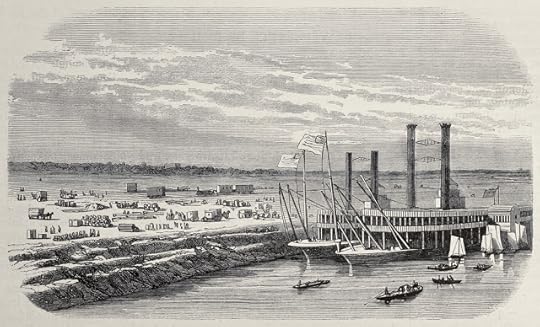
The sprawling, unpredictable Missouri River provides the perfect landscape for my story about a restless man whose goal is to stay one step ahead of civilization.
In those days, it took nerves of steel to pilot a steamboat on the wild, untamed Missouri River. A few of the things steamboat pilots encountered: elusive, ill-defined and ever-changing channels, getting stranded in low water, innumerable and often invisible snags, whirlpools, Indian attacks--to name but a few.
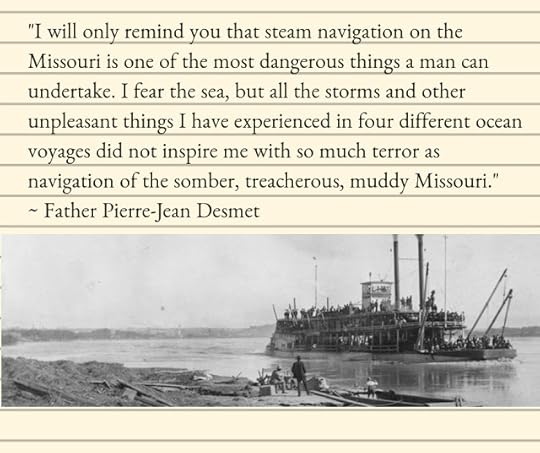
According to the U.S. Army Corps of Engineers, close to 300 steamboats went down in the river between 1830 and 1902. Historians estimate almost half of all the boats that plied the Missouri were lost to various accidents, with snags taking most of them to their watery grave. The “Muddy Mo” had a voracious appetite for steamboats!
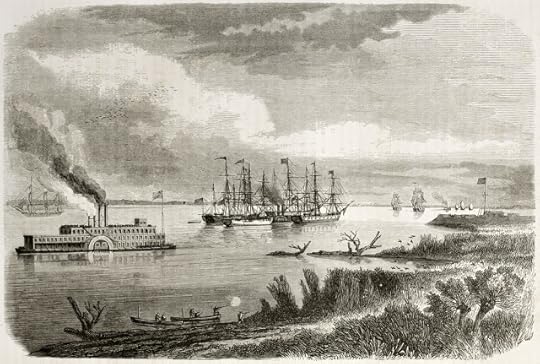
Near Kansas City, a construction company dug up a steamboat from the 1850s out of a farm field (the river had long since changed course). While there were no human casualties, the boat went down with its entire load of supplies. The Steamboat Arabia exhibit at the Kansas City riverfront is filled with some of the most well preserved displays of 19thcentury goods you’ll find anywhere.
The type of boat Huck pilots is a "mountain boat.” These sternwheelers were smaller and lighter, equipped with spars, which were a bit like stilts to help the boat "walk" over obstacles. One of the best-known mountain boats was the Far West, piloted by Captain Grant Marsh.
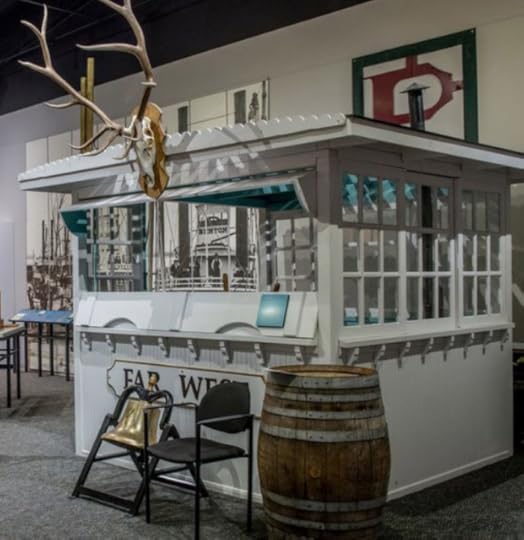 Far West pilothouse replica
Courtesy Dave Thomson Gallery.
Far West pilothouse replica
Courtesy Dave Thomson Gallery.A replica of the Far West pilothouse shows a pair of antelope antlers mounted in front to indicate it was a "fast boat" -- Grant made a record-breaking run down the Missouri River in 1876 after he picked up the wounded from the Battle of Little Big Horn.
Packet steamboating on the Missouri River lasted from the 1820s to the 1880s, with the greatest period of activity between 1840 and 1860. The railroads contributed primarily to the demise of steamboat business by siphoning off long-haul passenger and freight business. In 1867, there were 71 steamers regularly plying the Missouri River. Three years later there were only 9. (Wild River, Wooden Boats, Michael Gillespie, Heritage Press).
Some of the landing points mentioned in Taming Huck Finn were busy ports in the 1870s: Weston, Missouri, Sioux City, Iowa, Fort Sully in the Dakota Territory, Kansas City, and eventually St. Louis, where the Missouri and Mississippi rivers converge.
His greatest adventure is about to catch up with him.
Starched and proper, Miss Hallie MacBride is determined to atone for past sins by raising her estranged sister’s son. She doesn’t expect footloose Mr. Finn to challenge her, much less up and run off with her nephew.
On a wild journey fraught with danger, a freedom-loving adventurer and an avowed spinster battle over the destiny of a young boy, who is doing his level best to convince them they belong together.
Excerpt

June 2, 1870, Atchison, Kansas
“What you layin’ in there for, mister?”
A childish voice disturbed Huck’s sleep. He screwed his eyes tightly shut, willing his mind to return to dreams of pleasanter things than inquisitive children.
Something struck the bottom of his boot.
He jerked awake, his head connecting with a crack against the inside of the hogshead barrel. “Ow! Blame it.”
Gingerly, he touched a rising lump and grimaced at the painful reminder of where he’d ended up. After celebrating into the wee hours, it appeared a convenient place to await the next packet chugging up the Missouri River. Sobriety declared it a bad idea. Only halfwits and drunks slept in discarded barrels. Not men who commanded steamboats.
Curling around, he squinted at the opening where his legs were exposed. Daylight outlined the figure of a child. Hopeful it was just a dream Huck shut his eyes. When he opened them again, the boy had bent to peer inside the barrel.
Gap-toothed smile, snub nose, merry eyes that held the promise of mischief…
“Tom?” Huck rasped.
The boy giggled.
No, he couldn’t possibly be. Tom had been nearly full-grown fifteen years ago. Huck rubbed his stinging eyes. He must’ve gotten ahold of some bad brew like the Fire Rod his old man used to swig by the jug full; that stuff made Pap see crazier things than a boy that wasn’t there.
The spitting image of Tom laughed again. “Uncle Huck?”
Uncle? Huck shook his head to clear it. By God, he’d swear off whiskey forever if it brought on these strange imaginings, and it had to be his imagination. Huck Finn weren’t nobody’s uncle.
~~~
Giveaway
E.E. Burke is giving away one autographed copy of of her fabulous book “Taming Huck Finn.”
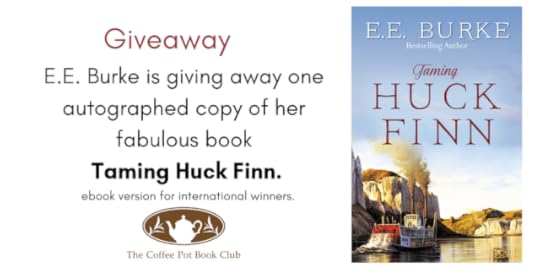
To be in with a chance just answer this question...
I’ve always wanted to go back in time and take a steamboat journey up the Missouri River. If you could travel in a time machine, what kind of adventure would you want to pursue?
Giveaway Rules
• Leave your answer in the comments at the bottom of this post.
• Giveaway ends at 11:59pm GMT on March 4th.
• You must be 18 or older to enter.
• Giveaway is open *internationally.
*International winners will receive ebook version.
•Only one entry per household.
• All giveaway entrants agree to be honest and not cheat the systems; any suspect of fraud is decided upon by blog/site owner and the sponsor, and entrants may be disqualified at our discretion.
•Winners will be announced in the comments.
You can join the adventure. Pick up your copy of Taming Huck Finn at the following retailers:
Amazon | B&N| iBooks| Kobo
E.E. Burke
 E.E. Burke is a bestselling author of historical romances that combine her unique blend of wit and warmth. Her books have been nominated for numerous national and regional awards, including Booksellers' Best, National Readers' Choice and Kindle Best Book. She was also a finalist in the RWA's prestigious Golden Heart® contest. Over the years, she’s been a disc jockey, a journalist and an advertising executive, before finally getting around to living the dream--writing stories readers can get lost in.
E.E. Burke is a bestselling author of historical romances that combine her unique blend of wit and warmth. Her books have been nominated for numerous national and regional awards, including Booksellers' Best, National Readers' Choice and Kindle Best Book. She was also a finalist in the RWA's prestigious Golden Heart® contest. Over the years, she’s been a disc jockey, a journalist and an advertising executive, before finally getting around to living the dream--writing stories readers can get lost in. Connect with E.E. Burke: Website • BookBub • Facebook • Twitter • Goodreads • Tumblr • YouTube • Amazon Author Page
Published on February 21, 2019 23:00
NewRelease — An Officer’s Vow, by Penny Hampson #Regency #HistoricalRomance @penny_hampson
An Officer’s Vow
By Penny Hampson
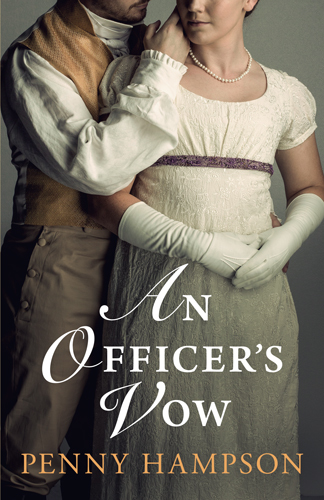
The future looks bleak to Major Nate Crawford. Depressed after being sent home from the Peninsular Campaign as unfit for service, he contemplates ending it all. Then an unexpected opportunity for adventure beckons in the shape of a delightfully intriguing runaway heiress. He will prove his worth as an officer and a gentleman by offering his help. He has a plan…Lottie Benham is desperate. Her life is in danger and she needs a place of safety until her next birthday. The unexpected proposal from this attractive, but intimidating officer could be the answer to her prayers. Not normally a risk-taker, she decides to gamble all by placing her trust in this charismatic gentleman, who she suspects might be more in need of help than she.But the best laid plans…Caught up in conflict, danger, and deception, will Lottie and Nate survive to find the perfect solution to their problems?
Amazon UK • Amazon US
Penny Hampson
 Having worked in various sectors before becoming a full time mum, Penny Hampson decided to follow her passion for history by studying with the Open University. She graduated with honours and went on to complete a post-graduate degree.Penny then landed her dream role, working in an environment where she was surrounded by rare books and historical manuscripts. Flash forward nineteen years, and the opportunity came along to indulge her other main passion – writing historical fiction. Encouraged by friends and family, three years later Penny published her debut novel A Gentleman’s Promise.Penny lives with her family in Oxfordshire, and when she is not writing, she enjoys reading, walking, swimming, and the odd gin and tonic (not all at the same time).Connect with Penny: Website • Twitter
Having worked in various sectors before becoming a full time mum, Penny Hampson decided to follow her passion for history by studying with the Open University. She graduated with honours and went on to complete a post-graduate degree.Penny then landed her dream role, working in an environment where she was surrounded by rare books and historical manuscripts. Flash forward nineteen years, and the opportunity came along to indulge her other main passion – writing historical fiction. Encouraged by friends and family, three years later Penny published her debut novel A Gentleman’s Promise.Penny lives with her family in Oxfordshire, and when she is not writing, she enjoys reading, walking, swimming, and the odd gin and tonic (not all at the same time).Connect with Penny: Website • Twitter
Published on February 21, 2019 23:00
February 20, 2019
A conversation with #HistoricalFiction author, Sherilyn Decter. Be sure to check out Sherilyn's fabulous #Giveaway #HFVBT @hfvbt
Historical Fiction Virtual Blog Tours Presents…

Innocence LostBy Sherilyn Decter

In a city of bootleggers and crime, one woman must rely on a long-dead lawman to hunt down justice…Philadelphia, 1924. Maggie Barnes doesn’t have much left. After the death of her husband, she finds herself all alone to care for her young son and look after their rundown house. As if that weren’t bad enough, Prohibition has turned her neighborhood into a bootlegger’s playground. To keep the shoddy roof over their heads, she has no choice but to take on boarders with questionable ties…When her son’s friend disappears, Maggie suspects the worst. And local politicians and police don’t seem to have any interest in an investigation. With a child’s life on the line, Maggie takes the case and risks angering the enemy living right under her nose…Maggie’s one advantage may be her new found friend: the ghost of a Victorian-era cop. With his help, can she find justice in a lawless city?Innocence Lost is the first novel in the Bootleggers’ Chronicles, a series of historical fiction tales. If you like headstrong heroines, Prohibition-era criminal underworlds, and just a touch of the paranormal, then you’ll love Sherilyn Decter’s gripping tale. A conversation with Historical Fiction author, Sherilyn Decter.
Please give a warm welcome to Historical Fiction author, Sherilyn Decter. Sherilyn could you tell us a little about yourself.
 A few years ago, I retired from a demanding job in the public sector. Staring ahead of me, for the first time in my life, was a blank slate. It was thrilling and intimidating to look out and see… nothing. It felt like I could become whoever I wanted to be, do whatever I wanted to do. It took almost a year to sort through the choices and decide on a course of action. Perhaps this is why the theme of a middle-aged woman at the crossroads of her life resonates with me. Write what you know, right?
A few years ago, I retired from a demanding job in the public sector. Staring ahead of me, for the first time in my life, was a blank slate. It was thrilling and intimidating to look out and see… nothing. It felt like I could become whoever I wanted to be, do whatever I wanted to do. It took almost a year to sort through the choices and decide on a course of action. Perhaps this is why the theme of a middle-aged woman at the crossroads of her life resonates with me. Write what you know, right? With the arrogance of most readers, I decided I wanted to write a book. ‘How hard can it be?’ Pretty darn hard, apparently. But I had time and passion, two Mexican rescue pups to keep me company, and a loving husband to listen to me whine.
Launching my fourth career, this time as an author of historical fiction has been an adventure. I love history, and I live in a century-old house. It is perhaps its creaks and groans that inspired the touch of paranormal in the series.
What inspired you to write Innocence Lost and the Bootleggers’ Chronicles series?
I have always had a deep love of history. From the legends of King Arthur to the temples of Julius Caesar, from Elizabethan palace intrigue to the trenches of World War I. Understanding, not just the who and what of the past, but also the why has always held me captive.
One era in American history that fascinates me is the Roaring Twenties. Americans had made it through the gauntlet of destruction and violence of the Great War to emerge on the other side; living for today, revealing in the casting off social values and expectations of their parents’ generation, determined to enjoy all that life could offer and then some. The music, the fashion, the opportunities for women; the 1920s were an exciting and dangerous time.
Overlay that with Prohibition, a government that dared to tell this devil-may-care hedonistic generation that they couldn’t do something and it’s bound to get interesting.
I always thought there is something wildly romantic about the 1920s — the dresses, the hairstyle, and the music. What kind of challenges did you faced while researching this period of history?
Some aspects of the Twenties are very well documented. I spent countless hours poring over fashion. There is something addicting about feathers, fringes, and sequins: I couldn’t take my eyes off them. (and if you too have a secret passion for flapper fashions, check out my Pinterest page… enough eye candy there to make Miss Fisher or the gals at Downton Abbey green with envy.)

The day to day life, when the bootleggers and flappers weren’t out cutting-a-rug, had less information. Fortunately, even though we are one hundred years away from those times, it’s still within the living memory of our older family members. Stories passed down by grandparents; secret illegal hooch runs in the dead of night by disreputable great-uncles, sepia-tinted wedding photographs of blushing brides and bashful grooms, are part of our collective memory.
The internet became my doorway into this era, and I knocked on many others’ doors in the process. If I had a specific question, I could fire off an email. What were the Business classes like in 1923, especially for women? An email to the archivist at Drexel University in Philadelphia (where the series is set) produced electronic copies of old recruitment brochures, photographs, and introductions to resident historians. What did nurses wear in 1924 in Hahnemann Hospital? There was a museum eager to help. Research is never a solitary process, and I want to give a huge shout out to all those that helped me make my books as authentic as possible.
I love researching and it sounds like you do as well. There are many books about Prohibition and the Roaring Twenties. Can you tell us three things that set your series apart?
Firstly, I wanted to look at what it was like as an ordinary person living through extraordinary times. Philadelphia was a bootlegger’s playground, albeit overshadowed by the gangsters in New York and Chicago. What did that mean for a widow struggling on a tight budget trying to raise her son and keep him safe? There were some critical choices for Maggie to make that need the spirit of those times to push her well outside her comfort zone. Some of them were good choices, and some had catastrophic consequences.
Like Maggie, all of us face forks in the road, of being put in impossible situations that ask much of us. The ultimate measure of a man is not where he stands in moments of comfort and convenience, but where he stands at times of challenge and controversy. (Martin Luther King).
Secondly, while Maggie is deeply and richly drawn, I didn’t want to shy away from some of the more unpleasant aspects of the era. It’s a book about bootleggers, and so there is crime and violence. It is a book about a woman devoted to her son and the memory of her husband, so there is minimal romance. Cracks begin to appear quickly in Maggie’s well-ordered world. The disappearance of her son’s friend, the arrival of a mysterious retired police detective, opening her home to lodgers, all push her along a path of rediscovering who she is.
Finally, the world is not ruined by the wickedness of the wicked, but by the weakness of the good. The foundation of the series is who will stand for justice and the consequences of when that call isn’t answered.
Your series sounds utterly enchanting. Can you tell us what you are currently working on?
I’ve just finished the five book series of the Bootleggers’ Chronicles. Inspired by the research and some of the characters I met along the way, I’ve just started work on the Rum Runners Chronicles set in Florida, the Bahamas, and Havana. This trilogy is also about a woman who is launching a new chapter in her life and is the story of how she thrives in the murky world of illegal liquor, sketchy speakeasies and blind tiger-gin joints.
It has been lovely talking with you, Sherilyn. Good luck with the rest of your tour.
Giveaway
During the Blog Tour we will be giving away two prize packs of a copy of the book, a set of Paper Dolls, and a Jazz Age Fashion Coloring Book! You can enterHERE!Giveaway Rules
• Giveaway ends at 11:59pm EST on February 22nd. You must be 18 or older to enter.• Giveaway is open internationally.
• Only one entry per household.• All giveaway entrants agree to be honest and not cheat the system; any suspect of fraud is decided upon by blog/site owner and the sponsor, and entrants may be disqualified at our discretion.• Winner has 48 hours to claim prize or new winner is chosen.
Grab a Free Kindle copy of Innocence Lost — 21st February 2019AVAILABLE ON AMAZON
Sherilyn Decter
 Sherilyn Decter is a writer, researcher, and lover of historical fiction. Her work is set in the Roaring Twenties and if you like feisty and determined heroines, complex cover-ups, Prohibition stories about criminal underworlds, police and political corruption, then you’re going to love Sherilyn’s grand gangster tales.For more information, please visit Sherilyn Decter’s website. You can also find her on Facebook, Twitter, Instagram, Goodreads and Pinterest.
Sherilyn Decter is a writer, researcher, and lover of historical fiction. Her work is set in the Roaring Twenties and if you like feisty and determined heroines, complex cover-ups, Prohibition stories about criminal underworlds, police and political corruption, then you’re going to love Sherilyn’s grand gangster tales.For more information, please visit Sherilyn Decter’s website. You can also find her on Facebook, Twitter, Instagram, Goodreads and Pinterest.
Published on February 20, 2019 23:30
Life in the time of a Viking shield maiden, by Sarah Dahl #History #Vikings #ShieldMaiden @sarahdahl13
Life in the time of a Viking shield maidenBy Sarah Dahl

In my collection of sensual short stories, the “Tales of Freya”, we encounter quite a number of Viking warriors, naturally. But one couple stands out: it’s Aldaith and his fierce shield maiden Nyssa. She is exotic and an exceptional character – and a rare sight for the time: a female fighter. The two of them have three stories in my collection to span their fighting- and love-life together. You can watch them meet in a river after battle, then how their relationship deepens and turns their lives around, and in the end their grave is found and the story of their last battles uncovered by archaeologists.So much for the romance and fighting.
In this post I want to look at what a day in their life could have been like, and especially for the rare woman among the fighters. Nyssa, the shield maiden, was surely a possibility as recent research suggests, but she also wasn’t the norm. A woman’s place was at home, not in the shield wall. The more fun it was to write her as the tempting and strong-willed fighter who can take on any man. She spends her days training with the guys, getting bruised and defeating some. I’m assured by reenactors that female fighters can indeed win any duel if they’re fast and agile enough. So her sensual duel in “Bonds” (found in the “Tales of Freya”), where she defeats the stronger but slower Aldaith, is kind of accurate.
So what else would these warriors have been doing, a thousand years ago? Tied to a chieftain by oath, but able to leave and earn a living with someone else if they wanted to?
To begin with, the chieftain would call the warriors in, they would form a temporary band, swear oaths, present their weapons, and board the dragon boats, headed to wherever the next campaign should take place. So far so good.
Let’s say our warriors went to that lovely lush island where the Anglo-Saxons lived, sailed or rowed up a convenient river, taking turns at the oars, hours on end. Nyssa would have rowed just the same as the men. Comradeship was everything. At some point, they would have decided on a place to set up camp. The shipmaster would make them beach the boat or moor in a flat but sheltered place. They would hop ashore and light fires – if they dared, weapons always close to hand in these hostile surroundings. They would know exactly what to do to stay undiscovered; they would know their rank and duties.
And they would have been hungry! Some men might go off to plunder a nearby farmstead for the night-meals. Some would take up watch to protect the band, others would go spying to make sure they stayed ahead of the enemy.
Their few belongings were in chests on board the ship. They surely carried the most valuable items on their bodies – and there would have been guards on the ships to protect their belongings.
Ashore, around the fires, the warriors prepared the food. And after days of rowing the ship, they needed calories! They might have cooked or unpacked something the Ribe Viking Centre calls “Ship’s biscuits”: smoked pork is diced and fried on a hot pan. They added chopped onion and mixed it with whey, salt, barley flour and wheat meal, then made the dough into balls and then into flat breads. Those biscuits were again baked on a dry pan until they were dry and hard – and therefore preserved for many weeks of raiding. Our shield maiden wouldn’t have been the one cooking just because she was a woman! She was equal, a comrade, and men had to know how to cook to survive travelling anyway.
Some men might open their knapsacks and take out any sort of fish, meat, preserved with salt, dried, or smoked. They had lamb sausages, butter and cheese, honey, dried fruit and nuts. They also loved eggs in brine (called Solæg), and of course breads: rye loaves, crispbread. Bread would mostly be flat and unfermented to keep for months.

Most of this would have been prepared at home or in a base camp before heading off, transported in saddle bags, knapsacks, or in the chests and baskets aboard. (here’s an amazingly authentic video by Hands on History to see what travel food preparation could have looked like:
So once everyone was fed, had drunk their beer or whey, sung and wrestled, they’d have gone to sleep ashore or on board, maybe under the taken down sail to protect them from the English weather. We remember: Viking ships had no shelter at all. The men and women explorers and fighters were at all times confronted with the harshest elements, be it in a lovely calm estuary in northern France or the roaring Atlantic on their way to Iceland and beyond.
Were I a chieftain then and had a day of battle ahead, I’d have ordered my men to not stay up too late. I’m sure our Nyssa would have snuggled up to her Aldaith under their blankets, for some much needed warmth and consolation in the hours before reaching the battlefield. Their swords would have been within reach, and men will have patrolled at all times. The couple might have watched across the fire as restless comrades sat long into the night to tend to their weapons and talk the fear away.
Maybe their chieftain’s voice would lull them to sleep … explaining at length the battle tactics for the following day – or the location of the nearest promising monastery. I’m not sure how long our couple would have listened … or if they would have liked some bouncy cuddles to counter the tension. It sure wouldn’t have raised any eyebrows if they did. Maybe my psychology is right that some hot physical contact was a relief and distraction, a reassurance before they locked shoulders on the battlefield at dawn. Never knowing if they would survive – or if one or both of them would be collected by the Valkyries the next night.
To find out what happened in Aldaith and Nyssa’s last battle, you should refer to their last story “Battles” in the “Tales of Freya” ;-)
Additional source: Ribe VikingeCenter
Tales of Freya

A collection of sensual short stories set in the Viking Age
In a world of crackling fires and rough landscapes, long winters and bloody raids, the immediacy of life and death ignites undeniable passions. Warriors and monks, healers and housewives – all follow the call of their hearts and bodies to indulge in pleasures that may forever change their lives.
In this collection of adult bedtime stories, Sarah Dahl pulls back the curtain of history to depict the erotic lives of Viking men and women. Amid the stark landscapes of fjords, forests and snowcapped mountain peaks, her characters search for love and passion. Dahl authentically illuminates the sensual side of a world of battle and plunder in an alluring collection perfect for every lover of gritty Viking romance.
Amazon
Sarah Dahl
 Sarah Dahl lives on the edge of the rural German Eifel and writes historical fiction (novels and short stories) primarily set in the Viking age. She was an editor in several German publishing houses and managed a translation agency. The magic of writing re-entered her life at UCD Dublin, where she sat in J.R.R. Tolkien’s office every day, while working on the ‘Dictionary of Hiberno-English’. Tolkien’s spirit must have done something to her creative muscles – it sure wasn’t the bland view from his office. She became a full-time writer soon after and still works as an editor, translates, and coaches new authors. She is interested in everyday life in bygone centuries and the human stories that may have occurred behind the hard, historical facts. Her author page is: sarah-dahl.com. You find her newsletter at: https://mailing.sarah-dahl.com.Connect with Sarah: Blog • Mailing List • Facebook • Twitter • Goodreads.
Sarah Dahl lives on the edge of the rural German Eifel and writes historical fiction (novels and short stories) primarily set in the Viking age. She was an editor in several German publishing houses and managed a translation agency. The magic of writing re-entered her life at UCD Dublin, where she sat in J.R.R. Tolkien’s office every day, while working on the ‘Dictionary of Hiberno-English’. Tolkien’s spirit must have done something to her creative muscles – it sure wasn’t the bland view from his office. She became a full-time writer soon after and still works as an editor, translates, and coaches new authors. She is interested in everyday life in bygone centuries and the human stories that may have occurred behind the hard, historical facts. Her author page is: sarah-dahl.com. You find her newsletter at: https://mailing.sarah-dahl.com.Connect with Sarah: Blog • Mailing List • Facebook • Twitter • Goodreads.
Published on February 20, 2019 22:30
February 19, 2019
Historical Fiction author, Jayne Davis, is taking a look at duelling and its place in history. #History #HistoricalFiction
Amazon UK • Amazon US
Jayne Davis
 Jayne Davis writes historical romances set in the late Georgian/Regency era, published as both ebooks and paperbacks.She was hooked on Jane Austen and Georgette Heyer as a teenager, and longed to write similar novels herself. Real life intervened, and she had several careers, including as a non-fiction author under another name. That wasn't quite the writing career she had in mind...Finally, she got around to polishing up stories written for her own amusement in long winter evenings, and became the kind of author she’d dreamed of in her teens. She is now working on the first few books in the Marstone Series, set in the late Georgian/early Regency period.
Jayne Davis writes historical romances set in the late Georgian/Regency era, published as both ebooks and paperbacks.She was hooked on Jane Austen and Georgette Heyer as a teenager, and longed to write similar novels herself. Real life intervened, and she had several careers, including as a non-fiction author under another name. That wasn't quite the writing career she had in mind...Finally, she got around to polishing up stories written for her own amusement in long winter evenings, and became the kind of author she’d dreamed of in her teens. She is now working on the first few books in the Marstone Series, set in the late Georgian/early Regency period.Connect with Jayne: Website • Pinterest • Goodreads.
References: Reenactment trial by combat image – open source — WikimediaPistol duel - open source — Wikimedia
<!-- /* Font Definitions */ @font-face {font-family:"Cambria Math"; panose-1:2 4 5 3 5 4 6 3 2 4; mso-font-charset:0; mso-generic-font-family:roman; mso-font-pitch:variable; mso-font-signature:-536870145 1107305727 0 0 415 0;} @font-face {font-family:Calibri; panose-1:2 15 5 2 2 2 4 3 2 4; mso-font-charset:0; mso-generic-font-family:swiss; mso-font-pitch:variable; mso-font-signature:-536859905 -1073732485 9 0 511 0;} @font-face {font-family:garamond; panose-1:2 2 4 4 3 3 1 1 8 3; mso-font-charset:0; mso-generic-font-family:roman; mso-font-pitch:variable; mso-font-signature:647 0 0 0 159 0;} /* Style Definitions */ p.MsoNormal, li.MsoNormal, div.MsoNormal {mso-style-unhide:no; mso-style-qformat:yes; mso-style-parent:""; margin-top:0cm; margin-right:0cm; margin-bottom:8.0pt; margin-left:0cm; line-height:107%; mso-pagination:widow-orphan; font-size:11.0pt; font-family:"Calibri",sans-serif; mso-ascii-font-family:Calibri; mso-ascii-theme-font:minor-latin; mso-fareast-font-family:Calibri; mso-fareast-theme-font:minor-latin; mso-hansi-font-family:Calibri; mso-hansi-theme-font:minor-latin; mso-bidi-font-family:"Times New Roman"; mso-bidi-theme-font:minor-bidi;} a:link, span.MsoHyperlink {mso-style-priority:99; color:#0563C1; mso-themecolor:hyperlink; text-decoration:underline; text-underline:single;} a:visited, span.MsoHyperlinkFollowed {mso-style-noshow:yes; mso-style-priority:99; color:#954F72; mso-themecolor:followedhyperlink; text-decoration:underline; text-underline:single;} .MsoChpDefault {mso-style-type:export-only; mso-default-props:yes; font-size:11.0pt; mso-ansi-font-size:11.0pt; mso-bidi-font-size:11.0pt; font-family:"Calibri",sans-serif; mso-ascii-font-family:Calibri; mso-ascii-theme-font:minor-latin; mso-fareast-font-family:Calibri; mso-fareast-theme-font:minor-latin; mso-hansi-font-family:Calibri; mso-hansi-theme-font:minor-latin; mso-bidi-font-family:"Times New Roman"; mso-bidi-theme-font:minor-bidi;} .MsoPapDefault {mso-style-type:export-only; margin-bottom:8.0pt; line-height:107%;} @page WordSection1 {size:612.0pt 792.0pt; margin:72.0pt 72.0pt 72.0pt 72.0pt; mso-header-margin:36.0pt; mso-footer-margin:36.0pt; mso-paper-source:0;} div.WordSection1 {page:WordSection1;} </style> -->
Published on February 19, 2019 23:00
Historical Fiction author, Margaret Verble is giving away five copies of her fabulous book — Cherokee America #CherokeeAmerica #MargaretVerble #HFVBTBlogTours @HMHBooks @hfvbt
Historical Fiction Virtual Blog Tours Presents….
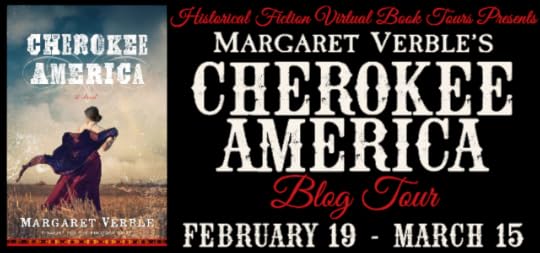
Cherokee AmericaBy Margaret Verble
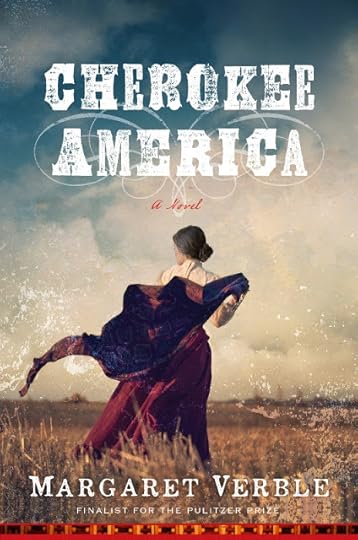
From the author of the Pulitzer Prize finalist Maud’s Line , an epic novel that follows a web of complex family alliances and culture clashes in the Cherokee Nation during the aftermath of the Civil War, and the unforgettable woman at its center.
It’s the early spring of 1875 in the Cherokee Nation West. A baby, a black hired hand, a bay horse, a gun, a gold stash, and a preacher have all gone missing. Cherokee America Singer, known as “Check,” a wealthy farmer, mother of five boys, and soon-to-be widow, is not amused.In this epic of the American frontier, several plots intertwine around the heroic and resolute Check: her son is caught in a compromising position that results in murder; a neighbor disappears; another man is killed. The tension mounts and the violence escalates as Check’s mixed race family, friends, and neighbors come together to protect their community—and painfully expel one of their own.Cherokee America vividly, and often with humor, explores the bonds—of blood and place, of buried histories and half-told tales, of past grief and present injury—that connect a colorful, eclectic cast of characters, anchored by the clever, determined, and unforgettable Check.
“In Verble’s hands, this tale of a mother’s love and her gritty resolve in a shameful era of false promises and broken treaties makes for a rich, propulsive novel.”Publishers Weekly
“Highly recommended for readers of literary historical fiction in the vein of Lalita Tademy’s Citizen’s Creek and Paulette Jiles’s News of the World.”Library Journal, STARRED review
Giveaway
During the Blog Tour we will be giving away five copies of Cherokee America by Margaret Verble! Enter the Giveaway HERE!Giveaway Rules
• Giveaway ends at 11:59pm EST on March 15th. You must be 18 or older to enter.
• Giveaway is open to US only.
• Only one entry per household.
• All giveaway entrants agree to be honest and not cheat the systems; any suspect of fraud is decided upon by blog/site owner and the sponsor, and entrants may be disqualified at our discretion.
• Winner has 48 hours to claim prize or new winner is chosen.WEBSITE • FACEBOOK • GOODREADS • AMAZON • BOOKBUB
Margaret Verble Margaret Verble is an enrolled and voting citizen of the Cherokee Nation of Oklahoma and a member of a large Cherokee family that has, through generations, made many contributions to the tribe’s history and survival. Although many of her family have remained in Oklahoma to this day, and some still own and farm the land on which the book is set, Margaret was raised in Nashville, Tennessee, and currently lives in Lexington, Kentucky.Many of the characters of Maud’s Line are based on people Margaret knew as a child and the setting is land she roamed for many years of her life. In part, Margaret wrote this book to keep those people and that land alive in her heart.Margaret’s new novel, Cherokee America, will be released by Houghton, Mifflin, Harcourt on Feb. 19, 2019. A prequel to Maud’s Line, it is set in 1875 in the Arkansas River bottoms of the old Cherokee Nation West.Margaret is a member of the Authors Guild and Western Writers of America.Connect with Margaret: WEBSITE • FACEBOOK • GOODREADS • AMAZON • BOOKBUB
Margaret Verble is an enrolled and voting citizen of the Cherokee Nation of Oklahoma and a member of a large Cherokee family that has, through generations, made many contributions to the tribe’s history and survival. Although many of her family have remained in Oklahoma to this day, and some still own and farm the land on which the book is set, Margaret was raised in Nashville, Tennessee, and currently lives in Lexington, Kentucky.Many of the characters of Maud’s Line are based on people Margaret knew as a child and the setting is land she roamed for many years of her life. In part, Margaret wrote this book to keep those people and that land alive in her heart.Margaret’s new novel, Cherokee America, will be released by Houghton, Mifflin, Harcourt on Feb. 19, 2019. A prequel to Maud’s Line, it is set in 1875 in the Arkansas River bottoms of the old Cherokee Nation West.Margaret is a member of the Authors Guild and Western Writers of America.Connect with Margaret: WEBSITE • FACEBOOK • GOODREADS • AMAZON • BOOKBUB

Cherokee AmericaBy Margaret Verble

From the author of the Pulitzer Prize finalist Maud’s Line , an epic novel that follows a web of complex family alliances and culture clashes in the Cherokee Nation during the aftermath of the Civil War, and the unforgettable woman at its center.
It’s the early spring of 1875 in the Cherokee Nation West. A baby, a black hired hand, a bay horse, a gun, a gold stash, and a preacher have all gone missing. Cherokee America Singer, known as “Check,” a wealthy farmer, mother of five boys, and soon-to-be widow, is not amused.In this epic of the American frontier, several plots intertwine around the heroic and resolute Check: her son is caught in a compromising position that results in murder; a neighbor disappears; another man is killed. The tension mounts and the violence escalates as Check’s mixed race family, friends, and neighbors come together to protect their community—and painfully expel one of their own.Cherokee America vividly, and often with humor, explores the bonds—of blood and place, of buried histories and half-told tales, of past grief and present injury—that connect a colorful, eclectic cast of characters, anchored by the clever, determined, and unforgettable Check.
“In Verble’s hands, this tale of a mother’s love and her gritty resolve in a shameful era of false promises and broken treaties makes for a rich, propulsive novel.”Publishers Weekly
“Highly recommended for readers of literary historical fiction in the vein of Lalita Tademy’s Citizen’s Creek and Paulette Jiles’s News of the World.”Library Journal, STARRED review
Giveaway
During the Blog Tour we will be giving away five copies of Cherokee America by Margaret Verble! Enter the Giveaway HERE!Giveaway Rules
• Giveaway ends at 11:59pm EST on March 15th. You must be 18 or older to enter.
• Giveaway is open to US only.
• Only one entry per household.
• All giveaway entrants agree to be honest and not cheat the systems; any suspect of fraud is decided upon by blog/site owner and the sponsor, and entrants may be disqualified at our discretion.
• Winner has 48 hours to claim prize or new winner is chosen.WEBSITE • FACEBOOK • GOODREADS • AMAZON • BOOKBUB
Margaret Verble
 Margaret Verble is an enrolled and voting citizen of the Cherokee Nation of Oklahoma and a member of a large Cherokee family that has, through generations, made many contributions to the tribe’s history and survival. Although many of her family have remained in Oklahoma to this day, and some still own and farm the land on which the book is set, Margaret was raised in Nashville, Tennessee, and currently lives in Lexington, Kentucky.Many of the characters of Maud’s Line are based on people Margaret knew as a child and the setting is land she roamed for many years of her life. In part, Margaret wrote this book to keep those people and that land alive in her heart.Margaret’s new novel, Cherokee America, will be released by Houghton, Mifflin, Harcourt on Feb. 19, 2019. A prequel to Maud’s Line, it is set in 1875 in the Arkansas River bottoms of the old Cherokee Nation West.Margaret is a member of the Authors Guild and Western Writers of America.Connect with Margaret: WEBSITE • FACEBOOK • GOODREADS • AMAZON • BOOKBUB
Margaret Verble is an enrolled and voting citizen of the Cherokee Nation of Oklahoma and a member of a large Cherokee family that has, through generations, made many contributions to the tribe’s history and survival. Although many of her family have remained in Oklahoma to this day, and some still own and farm the land on which the book is set, Margaret was raised in Nashville, Tennessee, and currently lives in Lexington, Kentucky.Many of the characters of Maud’s Line are based on people Margaret knew as a child and the setting is land she roamed for many years of her life. In part, Margaret wrote this book to keep those people and that land alive in her heart.Margaret’s new novel, Cherokee America, will be released by Houghton, Mifflin, Harcourt on Feb. 19, 2019. A prequel to Maud’s Line, it is set in 1875 in the Arkansas River bottoms of the old Cherokee Nation West.Margaret is a member of the Authors Guild and Western Writers of America.Connect with Margaret: WEBSITE • FACEBOOK • GOODREADS • AMAZON • BOOKBUB
Published on February 19, 2019 22:30
February 18, 2019
#NewRelease — SAVING WASHINGTON: The Forgotten Story of The Maryland 400 And the Battle of Brooklyn by Chris Formant #HistoricalFiction @cmforman
SAVING WASHINGTON
The Forgotten Story of The Maryland 400 And the Battle of Brooklyn
By Chris Formant
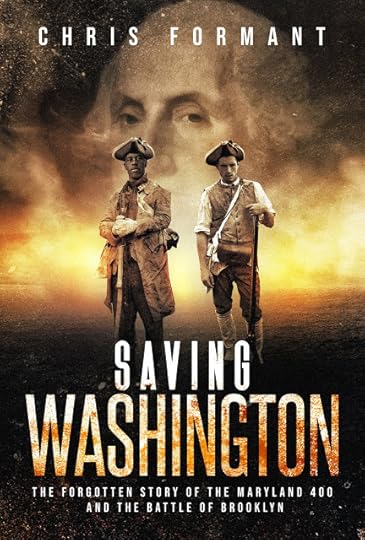
The lost story of “America’s 400 Spartans”—an army of unexpected heroes who changed the course of history.
On a marshy Brooklyn battlefield on August 27, 1776, four hundred men from Baltimore, Maryland assembled to do battle against a vastly superior British army. Seemingly overnight, these young soldiers had matured from naïve teenagers to perhaps the most important, yet most forgotten, citizen soldiers in all of American history: “America’s 400 Spartans.”
Saving Washington follows young Joshua Bolton and his childhood friend Ben, a freed black man, as they witness British tyranny firsthand, become enraptured by the cause, and ultimately enlist to defend their new nation in a battle that galvanized the American nation on the eve of its birth.
Chris Formant’s gripping tale blends real-life historical figures and events with richly developed fictional characters in a multi-dimensional world of intrigue, romance, comradeship, and sacrifice, transporting us two-and-a-half centuries back in time to the bustling streets of Baltimore and the bloody, smoke-filled carnage of battle in Brooklyn.
Excerpt
Courtesy of Permuted Press.
After the wake, she returned to her bedroom and shuttered the blinds. She lay back down and allowed the days to pass, not distinguishing morning from evening. She didn’t eat—she had no appetite whatsoever—only she did have a blurred recollection of Lydia coming and going with tea, which she had cajoled her into sipping.
“Why Sam…why?”
“Mary?” Lydia asked.
Mary didn’t realize she had uttered the words aloud and wasn’t aware of Lydia’s presence in her bedroom. She had no idea how long she had been hovering over her. “What do you want?” she snapped.
“It’s time,” Lydia answered, flinging open the blinds. The room instantly flooded with morning sunlight.
Mary, frozen on her bed, shielded her eyes with her arm.
Lydia had never seen her in such poor condition: She looked frayed and fragile, already shedding pounds from lack of sustenance. “Let me give you a hand…”
Lydia wasn’t about to give her any say in the matter. She took Mary by both hands and coaxed her into sitting up and then onto her feet. Lydia hardened her grip to help Mary as she waivered. Mary’s face flushed. “You all right?”
“A bit dizzy…but I’ll be all right,” Mary said, steadying herself on her own.
“We’d better get a move on; we’re a bit late,” Lydia said. “There’s quite a fuss out there already.”
Lydia helped Mary undress and hoist on an all-black dress with an embroidered matching shawl. She adjusted the silver brooch on Mary’s chest and then reached for a brush on the nightstand. Mary plucked the brush out of her friend’s hand. “No—I can brush my own hair, thank you very much.”
“Ah, good,” Lydia remarked, stepping back. “Returning to your wonderful old curmudgeon self, I see.”
Mary brushed out her knotted hair, wrapped it into a bun, and pinned it all together. Her color and strength were somehow returning to her all on their own.
“What are you going to say?” Lydia asked, handing her an appropriate black hat and thickly netted veil.
“I suppose I’ll know when I step out there,” she replied.
After a bit more primping, Mary announced, “Ready.”
They made their way through the house, opened the door, and paused together in the doorway, astonished at the sight in front of them: A stream of mourners dressed in black had gathered to pay their respects. Seeing Mary, they all began to remove their hats, out of respect. Further down the street, patriot supporters seethed with pent-up rage as they held protest signs and flags at their sides.
Mary felt her eyes become misty and gulped back tears. She was thankful to have the veil as a shield.
“Sam’s death has changed everything,” Lydia said, her voice quivering.
Mary smoothed the wrinkles in her dress with her hands and stepped forward into the mass of townspeople—whites and Negroes, men and women, merchants and dockworkers, city dwellers and local aristocrats in their finery—clapping in her honor. The reactions became deafening, engulfing her tiny frame.
When she reached the center of the crowd, she held up her pale hand and everyone fell silent. “Thank you all…for gathering here today,” she sputtered. “Sam…would have been honored by your presence.”
The crowd cheered. Mary could hardly believe that all of this fuss was for her husband, a reserved man who didn’t particularly enjoy being the center of attention.
“I was informed that my husband was killed four days ago…a senseless act of cowardice,” she said under her breath. “I have been trying to come to terms with it…to understand why. To know why the Lord would claim my husband…and why He did so in such a brutal manner. Sam was a moderate, religious, and peaceful man. He never harmed a soul…. He deserved nothing but honor and respect.”
Her surrounding audience responded with applause, but she would have none of it. She raised both hands and quieted them down with a voice that was unexpectedly strong and unbroken. “But that is not really the entire reason why you are all here, is it? It took me a long time—far too long—to realize that a terrible evil has infiltrated our land. They tax us with impunity. They force our businesses into debt. They march troops through our cities to the north. They treat us as if we are not worthy of their citizenship. Now they murder us in cold blood when we speak our minds. I say, ‘No more!’ There comes a time when even the lambs must fight against the wolves. I believe with all of my heart and with all my soul that the Lord is on the side of the lambs. We are the chosen ones who will be delivered!”
The claps, whistles, and cries surrounded her with such force that she once again became unsteady. She could hardly believe such rebellious words had come from her lips. But she was not finished…not yet. When the crowd simmered down, she continued, “I know many people in our colonies remain loyal to the Crown. Until this week, I too had doubts about our cause. But I say to you now: Any sovereign who would tax, pillage, and murder his own subjects does not deserve our loyalty. We are God’s children, not the king’s!”
She gazed downward, exhausted. The crowd roared out of control, chanting and cheering. Lydia held her shoulders for support—and to assure her of how well she had spoken.“That was the most inspiring speech I’ve ever heard in my life,” a patriot said to her. “Bless you, Mary, bless you,” sobbed one of her female neighbors.
Greenwood, with his arm in a sling and his eyes wet with tears, somehow found his way to her for an embrace. “You do a great honor to Sam…and all of us.”
She heard a familiar voice from behind. “Mother…I’m speechless.”
Before this tragedy had occurred, Mary had ruminated over the lecture she would give her son the next time she saw him: a harsh combination of inducing guilt and scolding him for having treated his own mother and father with such disrespect. But now that Josh stood right there in front of her—his boyish face smeared with tears—she helplessly fell into his arms and wept.
Amazon UK • Amazon US • B&N
Chris Formant
 Novelist Chris Formant is a student of history. He’s a former top executive of a multi-billion-dollar global business and now technology company CEO. Formant is an unlikely author of historical fiction, but the heroic story of Maryland’s Forgotten 400 drove him to assemble an expert team to help him conduct painstaking research and then write his highly anticipated second book, SAVING WASHINGTON.
Novelist Chris Formant is a student of history. He’s a former top executive of a multi-billion-dollar global business and now technology company CEO. Formant is an unlikely author of historical fiction, but the heroic story of Maryland’s Forgotten 400 drove him to assemble an expert team to help him conduct painstaking research and then write his highly anticipated second book, SAVING WASHINGTON.His debut novel, Bright Midnight, received lavish praise and has been dubbed the “Da Vinci Code for rock and roll fans.” In the thriller, Formant created a unique mystery in which he re-imagined the deaths of rock icons as murders. Chris divides his time between Baltimore, Maryland and Sedona, Arizona.
Connect with Chris: Website • Facebook • Twitter • Linkedin
Published on February 18, 2019 23:30
Life in the time of Time of the Tudors: London’s Prisons, by Dean Hamilton #History #Tudor #Prisons @Tyburn__Tree
Life in the time of Time of the Tudors: London’s Prisons By Dean Hamilton
“It is enough to know, too much to see,
That in the Counter there is room for thee” William Fennor, The Counter’s Commonwealth
On September 22nd, 1598, two men wandered out into the damp fields of Hoxton, north of London. On that muddy ground, they drew swords – at least one of which was “a certain sword of iron and steel called a rapier, of the price of three shillings” and fought. At the end of the affray, one man lay dead, suffering “a mortal wound, to the depth of six inches and the breadth of one inch” to his right side. That man was Gabriel Spencer, a play-actor in the Lord Admiral’s Men and the man that killed him was Ben Jonson, the playwright, friend of William Shakespeare and one of the most famous dramatists of the age.
 Ben Jonson, Spenser's killer.
Ben Jonson, Spenser's killer.Jonson was imprisoned in Newgate, one of London’s more notorious prisons, until his October court date when he pled guilty to the indictment. At his indictment, the playwright claimed “benefit of clergy”, an ancient legal loophole for literates that allowed “clergy” to escape or mitigate sentences by the secular legal courts in favour of the more lenient ecclesiastical courts. Jonson read the required “neck-verse” (Psalm 51) that demonstrated he could be considered “clergy”, was branded on the hand, and released.
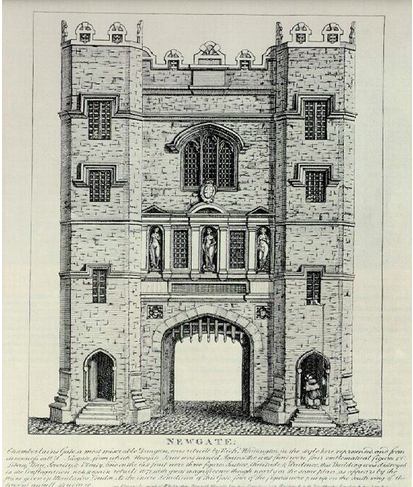
Old Newgate Prison
London abounded with prisons.
Prisons were part of the febrile landscape of the city, a part and parcel of its existence, as much as palaces, markets, churchyards and cathedrals. They were as much a part of London as the steady bustle of commerce in Cheapside or the churning tidal flux of the Thames. They had age and substance and a long, checkered weight of history that was old even in Elizabethan times.
With an estimated 14 major prisons, London is believed to have had more than any other European capital. These prisons included the Tower of London (usually reserved for Royal prisoners and prisoners of particular note), the Gatehouse (mainly political prisoners and controlled by the Privy Council and the Bishop of London), the Fleet (for debtors), Newgate (debt and serious criminal felonies such as murder, arson and thievery), Ludgate, Poultry Counter, Wood Street Counter (for theft), Bridewell (a women’s prison for vice-related crimes such as prostitution), White Lion, the King’s Bench (debtors), Marshalsea (religious offenders and maritime offences), Southwark Counter, the Clink (often Catholic priests & recusants), and St. Katherine’s.
Newgate was established in 1188 AD. The Fleet was built in 1197 AD, while the Clink dates back as far as 860 AD, originating as cells in a priest’s college operated by the Bishop of Winchester. The Wood Street Counter, Poultry Counter and Bridewell were all comparatively new prisons established in the mid-16th century. Bridewell was one of Henry VIII’s palaces, and was passed to the City of London Corporation by the young and short-lived Edward VI to be used as an orphanage, a work-house and a place of correction for “disorderly women”.

Bridewell Prison, Copperplate Map of London (1553-1558)
How did you end up in an Elizabethan prison? It’s important to note that prison was not generally considered a punishment. It was where you were held to await punishment – whether that was payment of your debts, a public whipping, the stocks or the noose or any of the other highly inventive sentences that could be inflicted upon anyone found guilty. The most common reasons for imprisonment were debt and assault, although in truth virtually anyone with a grudge and coin could swear out a warrant and have someone arrested. One characteristic of Elizabethan-era constabulary was they often seemed to be infinitely swayable by mendacity and greed. Gamini Salgado, the author of the classic The Elizabethan Underworld, notes that the sergeants of the Watch were highly adept at playing the middle position, accepting payments and bribes from both the complainants and suspects, until one “outbid” the other.
Prisons themselves were very much a “pay-as-you-go” experience with various levels of accommodation suitable to a prisoner’s station and purse. The Counter had three levels of accommodation available – the Master’s Side, the Knight’s Ward and the Hole. The Master’s Side provided private accommodation, bedding and access to better quality food, but always at a steep price and requiring a continuous stream of payments to the wardens and Keepers of the prison. When coin ran out, the prisoner would be shifted to the Knight’s Ward, which was less accommodating but every bit a pernicious in separating the woeful prisoner from his coin. The last stop on this inevitable journey was the Hole, a brutal and squalid accommodation typified by the number of prisoners that died of disease, exposure and starvation.
Debtors, in particular, found imprisonment a significant problem. It was virtually impossible to work to pay off ones debts while being held, and, as noted, debts in prison generally only rose as the rapacious costs mounted. Philip Stubbes, author of The Anatomy of Abuses, noted “It grieveth me, the pitiful cries and miserable complaints of poor prisoners in durance for debt and like so to continue all their life, destitute of liberty, meat, drink…and clothing to their backs, lying in filthy straw and loathsome dung, worse than any dog…”
There are also instances of individuals of means deliberately entering into custody to escape creditors, claiming bankruptcy while living a comfortable life on the Master’s Side until the desperate creditors were willing to negotiate a much reduced settlement to at least reclaim some small remuneration.
Almost all of London’s various prisons followed this same general pattern, with some minor variations. The Fleet’s version for the Hole was ironically nicknamed Bartholomew Fair, after one of London’s biggest Charter fairs held in August each year. Newgate in particular had a deeply malevolent reputation with its overcrowding, poor sanitary conditions and disease. In 1537, eleven Catholic monks, imprisoned by Henry VIII, were supposedly chained to pillars and allowed to starve to death. The prison was notorious for disease, violence, gaol fever and its unrelenting stench. Newgate’s version of the Hole, dubbed Limbo, was described as “full of horrors, without light and swarming with vermin and creeping things” and “a most fearful, sad, deplorable place…They lie like swine upon the ground, one upon another, howling and roaring…”. Newgate’s notorious reputation also gave rise to numerous rumors, folktales and ghosts, one of which served as the inspiration for my novella BLACK DOG. The Black Dog of Newgate was a spectral hound that would appear the night before an execution to collect the souls of the damned. It was only one of a number of amorphous haunts that called the prison home.
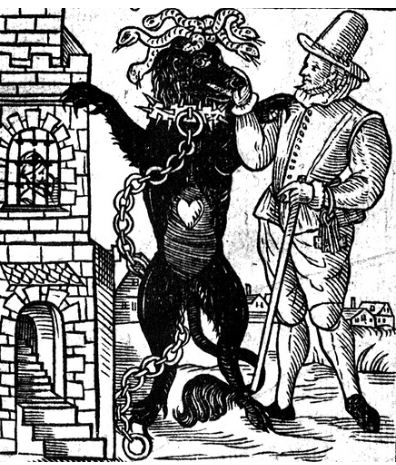
Drawing of the Black Dog of Newgate, from the book The Discovery of a London Monster Called the Black Dog of Newgate published in 1638.
The Elizabethan penal system was rife with abuse and corruption, stemming mainly from the utterly inadequate remuneration provided to manage the prisons, supply victualling and day-to-day operations. The Clink, whose name became synonymous with imprisonment in general, was widely considered to be the one place in London you could be guaranteed to find a Catholic priest or a recusant. It is believed the name is in reference to the sound the fetters and chains made, audible through a barred and grated window that opened onto the street where prisoners could speak to family members and receive charitable alms.
The death of Gabriel Spencer wasn’t Ben Jonson’s first brush with London’s penal system, nor was it his last. Jonson was imprisoned in the Marshalsea in 1597, notably with his future victim Gabriel Spencer and another play-actor, for "Leude and mutynous behavior” in writing and performing the play The Isle of Dogs. As The Isle of Dogs is lost to history, we have no clear idea of just what about that particular play offended the civil authorities enough to jail the three men. Jonson saw prison a third time in 1605 for offending King James’s Scottish sensibilities with his satirical play Eastward Ho. Despite the supposed punishment threat of having their noses and ears cut off, the men were released unscathed.

Title Page of Ben Jonson’s Eastward Hoe, which saw him imprisoned for the 3rd time in 1605.
It is clear the London’s prisons remain not just a penal threat on the urban landscape, but a significant impact on the cultural development and impact of the Elizabethan age. Thomas Nash (who co-wrote The Isle of Dogs with Jonson), noted of the Counter, “a gentleman is never thoroughly entered into credit till he hath been there”, stating “Trace the gallantest youths and bravest revelers about town in all the by-paths of their expense, and you shall infallibly find, that once in their lifetime they have visited the melancholy habitation….there is no place of the earth like it, to make a man wise…I vow that if I had a son, I would sooner send him to one of the Counters to learn law, than to the Inns of Court or Chancery.”
There is no record of William Shakespeare having spent any time in London’s many prisons, though based on his many contemporaries experiences, it might be surprising if the Bard had not seen that “melancholy habitation” at some point in his long career.
The Jesuit Letter
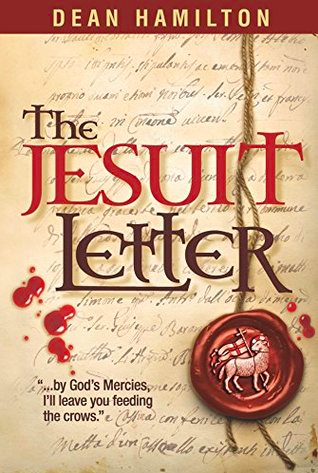
Ex-soldier turned play-actor Christopher Tyburn thought he had left bloodshed and violence behind him when he abandoned the war against the Spanish in Flanders, but fate has different and far bloodier plans waiting.
The innyards of London are closed due to plague and the Earl of Worcester's Men are on the road, touring the market-towns of the Midlands.
When Tyburn accidentally intercepts a coded letter from a hidden Jesuit priest in Warwickshire, he is entangled in a murderous and deadly conspiracy. Stalked by unknown enemies, he must race to uncover the conspiracy and hunt down the Jesuit to clear his name. . .or die a traitor's death. His only hope - an eleven-year old glover's son named William Shakespeare. Amazon
Black Dog: A Novella (The Tyburn Folios)
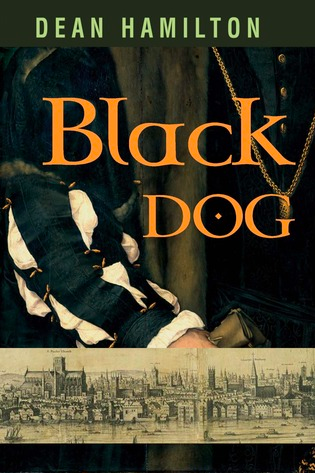
London, 1574
Hangings were always a good draw.
When the Earl of Worcester’s Men take advantage of the crowds drawn to a mass execution, they hoped for a strong turn-out and a fat payday. They didn’t expect to run afoul of London’s most notorious prison rooker, the Black Dog.
Now with one of the troupe facing slow death in gaol or penury in the face of the Black Dog’s threats, the troupe must turn to its newest member for help. Christopher Tyburn, ex-soldier turned play-actor, must dive into cesspool of London’s back-alleys, pursuing the Black Dog’s secrets in order to turn the tables on the deadly blackmailer.
But you don’t stalk the Black Dog without consequences….
Amazon
Dean Hamilton
 Dean Hamilton is the author of The Jesuit Letter, Black Dog, and the soon-to-be released (2019) Thieves’ Castle.
Dean Hamilton is the author of The Jesuit Letter, Black Dog, and the soon-to-be released (2019) Thieves’ Castle. The Jesuit Letter was selected as an HNS Editor’s Choice and short-listed for the 2016 HNS Indie Award. It was also short-listed for the 2016 M.M. Bennetts Award for Historical Fiction, honoured with an Indie BRAG Medallion and a Discovered Diamonds designation.
He was born in Winnipeg, Manitoba and spent the first half of his childhood chasing around the prairies and western Canada before relocating to Toronto, Ontario, Canada. He has three degrees (BA, MA & MBA), reads an unhealthy amount of history, works as a marketing professional by day and prowls the imaginary alleyways of the Elizabethan era in his off-hours. Much of his winter is spent hanging around hockey arenas and shouting at referees.
He is married, with a son, a dog, five cats and a turtle named Tortuga.
Connect with Dean: Website • Twitter • Goodreads.
Published on February 18, 2019 23:00
February 17, 2019
Writing tips — How to build a scene by S.J.A.Turney #amwriting #wordbuilding #tips @SJATurney
How to build a scene...
By S.J.A Turney

So, I write books. You probably know, or guess, that at least. And it occurred to me while working an edit on my draft recently that there are possibly authors out there who don’thave to repeatedly tweak what they’ve written. There may be people who write the perfect scene from square one and can just turn it over to their editor with a confident smile. I’m not one. You see, I think it’s because I write very fast. Working from my plan I will turn out a 5000 word chapter in a day’s work. But that is a draft. It will need self-editing before I can be happy with it. Each time I edit a scene (and some will take more editing than others) I build it up in layers. I’m going to give you a small example. Let’s start with this. I’m going to write a quick scene, just a paragraph or so long.
* * *
Philip adjusted his sword belt and straightened. The landsknecht with the greatsword and the scowl like a week-long thunderstorm simply narrowed his eyes and tapped a foot. So much for pre-amble, Philip mused, flexing his fingers.‘I can only apologise so many times before it becomes repetitive begging. I had no idea she was your sister.’The landsknecht’s narrowed left eye acquired an instant twitch. Good. Anything that might throw the man off balance had to help.
* * *
This, then is a basic and swiftly-written scene. It’s bones lacking flesh. The first thing I think when I look back over it is ‘where is the colour?’ It’s mechanics of a scene without the flesh. A terminator without the human touches. It needs to breathe, to live. Damn it. Let’s add some colour. Time for my first edit…

* * *
Philip adjusted his sword belt, the old tan leather flaking and falling away in fragments, and straightened to his full height. The landsknecht with the gleaming greatsword and the scowl like a week-long thunderstorm simply narrowed his steel-grey, unnerving eyes and tapped a heavy-booted foot impatiently. So much for pre-amble, Philip mused, flexing his bruised fingers and glancing down at them in worry.‘I can only apologise so many times before it becomes repetitive begging. I had no idea she was your sister.’The landsknecht’s narrowed left eye acquired an instant twitch. Good. Anything that might throw the man off balance had to help.
* * *
Not much changed there, but just a read through and it looks better to me. Already it has acquired feeling and a touch more visual. And people might say that visual is for cinema, but the best literature is so cinematic you can almost watch the book. It needs to be visual. Ooh, so what about conditions? Atmosphere? Weather? Without that it’s still just really mechanical text. Time for another layer.
* * *
Philip adjusted his sword belt, the battered leather flaking and falling away in fragments, and straightened to his full height. The cold November day settled into his bones, doing little to quieten his already tattered nerves. Somewhere above him a crow cawed angrily. Philip shivered.
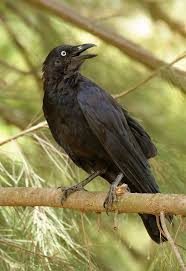 The landsknecht with the gleaming greatsword and the scowl like a week-long thunderstorm simply narrowed his steel-grey, unnerving eyes and tapped a heavy-booted foot on the frosty turf impatiently. So much for pre-amble, Philip mused, flexing his bruised fingers and glancing down at them in worry.‘I can only apologise so many times before it becomes mindless repetitive begging. I had no idea she was your sister.’The landsknecht’s narrowed left eye acquired an instant twitch and his breathing became deep and angry. Good. Anything that might throw the man off balance had to help. Crow shit clanged off the man’s shoulder plate. The twitch deepened even as Philip fought the rising laugh.
The landsknecht with the gleaming greatsword and the scowl like a week-long thunderstorm simply narrowed his steel-grey, unnerving eyes and tapped a heavy-booted foot on the frosty turf impatiently. So much for pre-amble, Philip mused, flexing his bruised fingers and glancing down at them in worry.‘I can only apologise so many times before it becomes mindless repetitive begging. I had no idea she was your sister.’The landsknecht’s narrowed left eye acquired an instant twitch and his breathing became deep and angry. Good. Anything that might throw the man off balance had to help. Crow shit clanged off the man’s shoulder plate. The twitch deepened even as Philip fought the rising laugh.* * *
Ooh, see what happened there? We acquired a whole new aspect to the scene. The crow became something of a character. On that pass, I also found myself removing just the odd word, because it can also be that less is more. I think my scene has all it needs now. It has the colour, the environment, the atmosphere, the personality and more. But what it has now is almost certainly too much of it. Time for my last pass. This time not to add a layer, but to streamline what I have. The best edits also include a surgical removal of bad tissue.* * *
Philip adjusted his sword belt, the battered leather flaking and falling away, and straightened. The cold November air settled into his bones, doing little to quieten his already tattered nerves. Somewhere above him a crow cawed, making him shiver.The landsknecht with the gleaming greatsword and the scowl like a week-long thunderstorm narrowed his steel-grey, disconcerting eyes and tapped a booted foot on the frosty turf. So much for pre-amble, Philip mused, flexing his bruised fingers and glancing down at them nervously.‘I can only apologise so many times before it becomes mindless begging. I had no idea she was your sister.’The landsknecht’s narrowed eye acquired a twitch and his breathing became deep and angry. Good. Anything that might throw the man off balance had to help. Bird shit clanged from the man’s shoulder plate. The eye twitch deepened even as Philip silently thanked the crow.
* * *
Now my scene is ready for the editor, I think. And if you’ve not noticed the huge difference in the passage, I would suggest that you pop back to the start, read the draft, and then zip right down here to the final version.So there you go. Scene building in layers. Might not be good for everyone, but for me it’s invaluable. Oh, and as a final thought, I’ll leave you to wonder how many edits the non-story parts of the text here had!
Praetorian: Lions of Rome

Rufinus is dead, crumpled at the base of a cliff in far-off Dacia. Or so the world believes. Back in the west, secretly in the entourage of the fierce Septimius Severus, the young hero moves in the shadows with fellow conspirators in an attempt to finally bring down the would-be tyrant of Rome: Cleander.
Under assumed names and in a variety of roles, the former Praetorian conspires with some of the most important men in Rome, bringing the city to the very brink of disaster in a grand and complex plot to cause the fall of the untouchable chamberlain.
And as governors, prefects, Praetorians and consuls work their secret plots in the seedy underbelly of Rome, Rufinus finds he has an opportunity to settle old scores along the way.
The empire is suffering. Rome is seething. Rufinus is back.
Amazon
Simon Turney

A born and bred Yorkshireman with a love of country, history and architecture, Simon spends most of his rare free time travelling around ancient sites, writing, researching the ancient world and reading voraciously.
Following an arcane and eclectic career path that wound through everything from sheep to Microsoft networks and from paint to car sales, Simon wrote Marius' Mules. Now, with in excess of twenty novels under his belt, Simon writes full time. He lives with his wife and children and a menagerie of animals in rural North Yorkshire.
Find Simon: Website • Blog • Facebook • Twitter.
Published on February 17, 2019 23:00
February 15, 2019
#BookReview — The Vogels: On All Fronts (The Half-Bloods Book 2), by Jana Petken #HistoricalFiction #WWII @AuthoJana
 The Vogels: On All Fronts (The Half-Bloods Book 2)By Jana Petken
The Vogels: On All Fronts (The Half-Bloods Book 2)By Jana Petken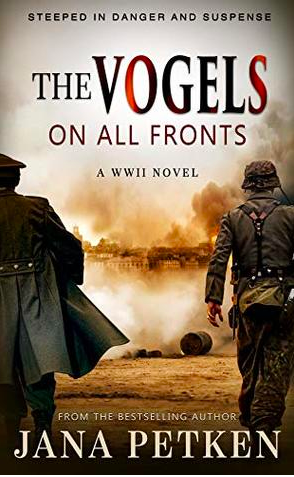
“The Vogels are fighting on all fronts in this compelling story of intrigue and betrayal in a world at war.”
European citizens feel the full force of German injustice, but not all are willing to bend the knee. From France to Poland, Resistance groups fight from the shadows to thwart Nazi rule and hinder their goal to exterminate Jews.
In Russia, Wilmot Vogel struggles to survive the ravages of a frigid winter, compounded by the German army’s lack of progress. Hit by a surprise Russian attack on the front lines, however, he finds himself facing an even greater challenge than the freezing weather and Soviet bullets.
In Łódź, Poland, an idealistic doctor is resolved to oppose the Third Reich, but is he willing to betray his country? Will a Gestapo major find the answers he’s looking for? Can a ghetto Jew avoid transportation to a Nazi extermination camp?
Can two spies rekindle their friendship, or will past betrayals become hurdles too great to surmount? Can Britain’s MI6 maintain the upper hand in a contest against the German Abwehr? Who wins when one man fights for British interests whilst the other seeks to undermine them?
In the darkest days of war, love flourishes. Two women with very different paths are led to one man who changes the course of their lives forever – but only one will win his heart.

“I’m still trying to wrap my head around Paul being married to a Gestapo Major’s daughter, Wilmot spending time in a prison camp, and your father being a British spy. What sort of family have I married into?”
Amazon UK • Amazon US
 Jana Petken is a bestselling historical fiction novelist and screenwriter.
Jana Petken is a bestselling historical fiction novelist and screenwriter. She is critically acclaimed as a bestselling, gritty, author who produces bold, colourful characters and riveting storylines. She is the recipient of numerous major international awards for her works of historical fiction and is presently in talks with film producers regarding one of her titles.
Before life as an author, she served in the British Royal Navy. During her service, she studied Naval Law and history. After the Navy, she worked for British Airways and turned to writing after an accident on board an aircraft forced her to retire prematurely.
Connect with Jana: Website• Twitter • Goodreads
Published on February 15, 2019 23:00
The Coffee Pot Book Club
The Coffee Pot Book Club (formally Myths, Legends, Books, and Coffee Pots) was founded in 2015. Our goal was to create a platform that would help Historical Fiction, Historical Romance and Historical
The Coffee Pot Book Club (formally Myths, Legends, Books, and Coffee Pots) was founded in 2015. Our goal was to create a platform that would help Historical Fiction, Historical Romance and Historical Fantasy authors promote their books and find that sometimes elusive audience. The Coffee Pot Book Club soon became the place for readers to meet new authors (both traditionally published and independently) and discover their fabulous books.
...more
...more
- Mary Anne Yarde's profile
- 159 followers



